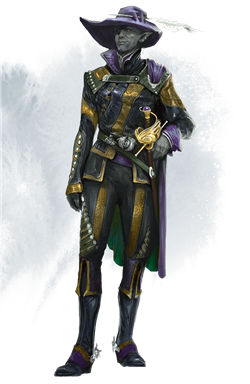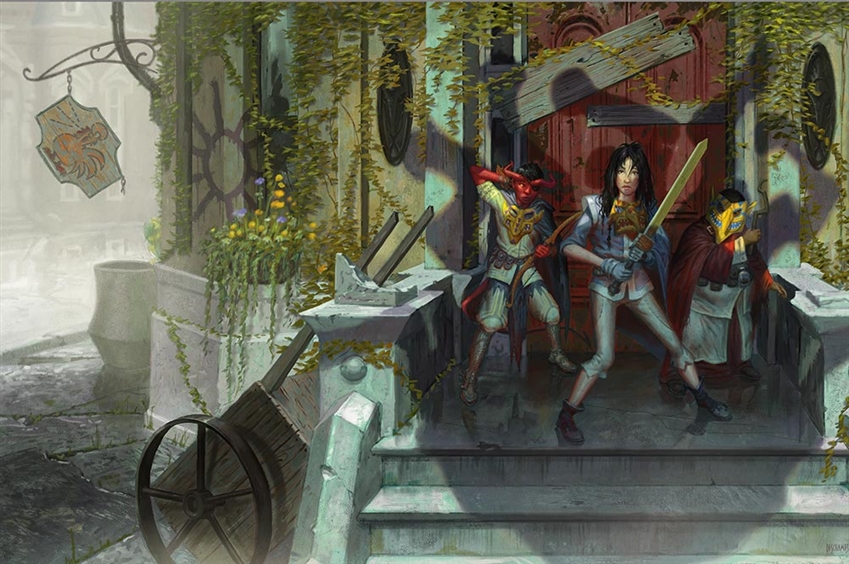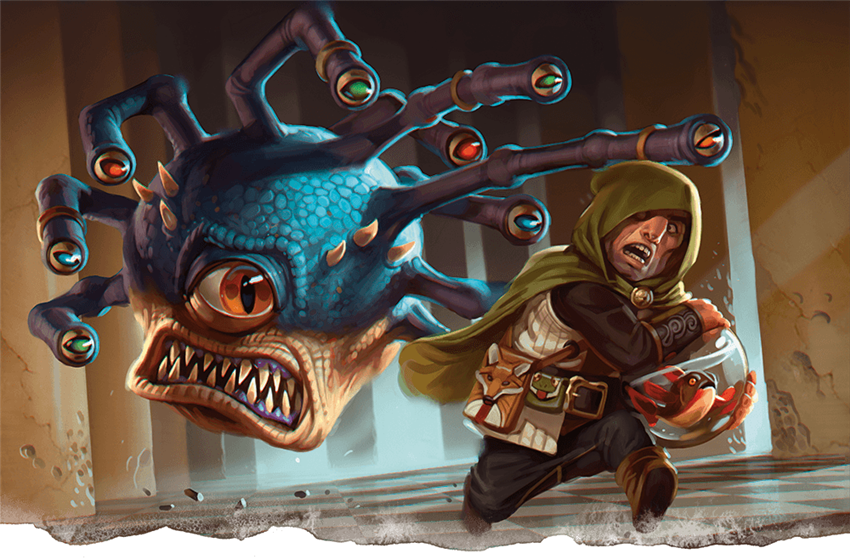 The villains of Waterdeep: Dragon Heist are some of the best in D&D history. The visages of Jarlaxle Baenre, Xanathar, Victoro and Ammalia Cassalanter, and Manshoon dominate the book’s cover, looming ominously over not only the fabled dragon’s hoard, but the city of Waterdeep itself. But even villains as flavorful and expressive as these are nothing without heroes to foil them. The best villains in storytelling have close relationships to their heroes, and separating one from the other would cause the individual stories to fall flat. To make the most of your villains in Waterdeep: Dragon Heist, you may want to intertwine your player characters and the villains before the story even begins. Here’s how.
The villains of Waterdeep: Dragon Heist are some of the best in D&D history. The visages of Jarlaxle Baenre, Xanathar, Victoro and Ammalia Cassalanter, and Manshoon dominate the book’s cover, looming ominously over not only the fabled dragon’s hoard, but the city of Waterdeep itself. But even villains as flavorful and expressive as these are nothing without heroes to foil them. The best villains in storytelling have close relationships to their heroes, and separating one from the other would cause the individual stories to fall flat. To make the most of your villains in Waterdeep: Dragon Heist, you may want to intertwine your player characters and the villains before the story even begins. Here’s how.
This article includes major spoilers for Waterdeep: Dragon Heist, and is intended for Dungeon Masters only.
Why Unite Your Heroes and Villains?
Dragon Heist’s villains were designed to be strong enough to stand on their own. As the villains of a published D&D campaign that will be played by hundreds of thousands of people worldwide, they have to be able to serve as foils for countless player characters. But it’s your job as the Dungeon Master to make these villains significant to your players. If they’re just bland villainous caricatures, your players will (rightfully) dismiss them out of hand. Even if your villains are credible threats, players who aren’t hooked by your villains’ character will only react to the danger and mechanical threat they represent.
By tying together your heroes’ and villains’ stories, you give the players a reason to interact with their rivals on a personal level. By adding personal tension to the mix, you raise the stakes of your adventure. A villain who wants to sacrifice the souls of the innocent is a pretty big deal, but you’ve probably never met all of those innocent people. Thwarting the evildoers is a matter of pure altruism in this situation. If your party isn’t made up entirely of do-gooders—and most parties in Waterdeep: Dragon Heist will be made up of scoundrels, not morally upright paladins—they probably won’t be questing simply because they’re yearning to protect the innocent. They need to have a reason. A motivation.
Villains are excellent motivators.

Types of Hero-Villain Relationships
Heroes can have all sorts different relationships to their antagonists. Some relationships are driven by character details, like parentage (Luke and Vader), apprenticeship (Batman and Ra’s al-Ghul), or rivalry (Drizzt and Jarlaxle). The list goes on, including every sort of intersection of identity, such as family, economic class, social status, and so on. If you aren’t afraid of tangling with “canon,” (such as it is in a shared RPG setting like the Forgotten Realms), then you can make some brave choices. Do a player want to be Jarlaxle’s estranged daughter? Why not! As long as that player and the Dungeon Master find a way to make it work, that sounds like the start of an excellent story.
If you don’t want to meddle with established lore, or meddling would jeopardize the story—the plot of Dragon Heist makes it challenging to introduce a player character as the child of the Cassalanters, for instance—then figure out how a character’s identities clash with the villain’s. If one of your players’ characters was born to loving parents that taught her to always be selfless, generous, and honorable, then she would be rightly appalled by the Cassalanters. They represent the moral inverse of what that character was taught to believe, and behave in the complete opposite way of their own parents. Instead of being comforting and empathetic, Lord Victoro and Lady Ammalia Cassalanter are cold and distant to their children, and their own greed has placed their children’s very souls in grave danger.
Once you’ve established points of identity for your character, there are two important things to consider when using them as the building blocks of a hero-villain bond. How do these identifiers oppose or align with the villain’s? Consider Batman and the Joker, especially this iconic duo’s depiction in The Dark Knight (2008). Both Batman and the Joker are vigilantes, meting out justice or injustice on their own terms. Both are disillusioned with Gotham City; they rightly see it as a festering husk, picked clean by gangsters. In these ways, their identities align.
But Batman is an agent of order. He believes, to a certain degree, in the inherent goodness of civilized people. Because of this, he not only strives to protect innocent lives, but he refuses to use guns or kill people. The Joker, on the other hand, is an agent of chaos. He believes that “when the chips are down, these civilized people… they’ll eat each other,” and he wants to create chaos in order to see his beliefs about society made manifest. In these ways, their identities are diametrically opposed.
And these various alignments and oppositions are why Batman and the Joker have such an enduring rivalry. Heath Ledger’s Joker’s admits it in the explicit text of the film: “You complete me.” The two are ideological opposites, putting them instantly in conflict, but their worldviews are largely the same. In this way, they see eye-to-eye, making their conflict all the greater. Batman sees a lot of himself in the Joker. A lot of what he hates about himself. And it makes him strive to be a more heroic person, even when the Joker is constantly trying to drag him down to his level and make him break his one cardinal rule: do not kill.
Creating Bonds with the Villains of Waterdeep: Dragon Heist
Those are the basics of creating emotionally charged hero-villain bonds. Figure out how your character is or isn’t related to the villain, then figure out how their beliefs, identities, and worldviews are aligned or opposed. Here are some traits associated with the villains of Waterdeep: Dragon Heist for you to compare and contrast your player characters against. Don’t be afraid to really play up these traits and make them melodramatic and larger-than-life; this is high fantasy, going a little overboard isn’t just expected, it’s encouraged.
Jarlaxle Baenre
The famed drow renegade Jarlaxle Baenre has appeared in dozens of Forgotten Realms novels. He is probably the best-known character on this list—save for perhaps Xanathar, thanks to the popularity boost he earned from Xanathar’s Guide to Everything. As such, Jarlaxle has the clearest canonical characterization out of any of these villains. As usual, don’t feel bound to these canon traits. They’re just a springboard for your imagination, and you can change as much as you want to… no matter what the purists say!
Jarlaxle was born into power, as the eldest son of House Baenre, one of the drow city of Menzoberranzan’s greatest noble houses. But despite this, he was discriminated against because of his gender, as drow society is a matriarchal culture that has been twisted to evil by the Spider Queen Lolth. As a male drow, he was trained to be a great warrior, and his position as a lowly male forced him to become cunning and manipulative in order to gain power.
While he eventually renounced his noble house, Jarlaxle is nevertheless one of the most socially powerful male drow in the Underdark. He is currently the captain of the Bregan D’aerthe, a mercenary company of other renegade male drow. He is also the secret ruler of Luskan, a city in the north of the Sword Coast, and he seeks to gain wealth to buy his way into the Lord’s Alliance and gain political power on the surface world.
The Xanathar
The great beholder crime lord known as Xanathar has gained an unexpected amount of popularity in the past few years. He looms behind the other villains on the cover of Waterdeep: Dragon Heist, grinning from the shadows, as if he is the true puppetmaster of this grand scheme. While he may not be a scheming mastermind, the Xanathar is adept at operating from the shadows. While the name of Xanathar is whispered with fear, only his closest associates know that the Xanathar is indeed a beholder. The Xanathar uses fear and misinformation to stay in power within the Xanathar Guild, and he does so by keeping his operation in a state of controlled chaos, sowing just enough discord to keep his underlings squabbling among themselves instead of organizing and supplanting him.
The Xanathar is deeply paranoid. He trusts no one, except for his one true companion, the giant fish Sylgar. Likewise, the Xanathar is prone to megalomania, and he is obsessed with gaining power, not just to dominate others, but to protect himself from others. He is easily provoked, and flies into terrible fits of rage when angered.
As an inhuman monster, the Xanathar may be the least relatable of Dragon Heist’s villains, but it’s still important to make him emotionally resonant. Make the players and their characters see the worst parts of themselves magnified in the Xanathar’s irredeemable evil.

The Cassalanters
Lord Victoro and Lady Ammalia Cassalanter are Waterdeep: Dragon Heist’s darkest villains. They’re also my favorites, because they are easily the most—and least—human of them all. Lord Victoro came from a powerful and wealthy family. He’s old money, and his banking business keeps his house rich. Ammalia married into the Cassalanter family, but is also of high birth. The Cassalanter family fell upon hard times three years ago, but Victoro and Ammalia reversed their fortunes by making a deal with Asmodeus and offering the souls of their three children (and all future children) in exchange for power and renewed fortune.
Victoro is handsome, well-schooled, suave, fashionable, and level-headed… but wracked with guilt for his children. Ammalia is beautiful, worldly, equally well-educated, and cold. She feels guilt most strongly for Osvaldo, her son who has already lost his soul. She is focused and goal-oriented, and wastes little time on sentimentality or worry for her surviving children. All that matters to her is success.
The Cassalanters are also the leaders of a secret cult of Asmodeus. They deeply fear being publically linked to the cult, but are safe in the knowledge that devil worship isn’t technically illegal, and their privilege and power will see them through any trouble.
Manshoon
Evil closer to pure evil than the Xanathar, Manshoon is a necromancer that has long since lost any semblance of humanity. He is a clone, and uses simulacra to enact his shadowy will within the City of Splendors. Manshoon’s motivations are straightforward: he wants the cache of dragons to bribe and manipulate the Masked Lords into making him the new Open Lord of Waterdeep. His enemies are many and powerful, and so he works best from the shadows, only making his presence known when victory is assured.
Manshoon lusts for domination, pure and simple. He will go to any lengths to gain the power to dominate others. Secondarily, he is one of the greatest archmages in existence, and he searches for ever-greater sources of magical power. Manshoon is also a being of infinite self-loathing; many years ago, the original Manshoon cloned himself and put all of his clones in stasis in an attempt to live forever… but a magical mishap caused all of his clones to awaken at once. They sought each other out and attempted to destroy each other. This Manshoon is one of three known Manshoon clones in existence.
Personalizing your Bonds
You may not need to make deep and intimate character bonds. I find that doing so enriches the drama of my D&D stories, but you may feel that it can push your tale too far into the realm of melodrama. Or you simply wish for your Waterdeep: Dragon Heist experience to be a fish-out-of-water tale, with the characters reacting to new and unusual events as they unfurl the mysteries of the City of Splendors. Even if this is your plan, I highly recommend finding ways to link your players’ characters to the villains, even just thematically. It could seriously raise the stakes of your campaign.
 James Haeck is the lead writer for D&D Beyond, the co-author of Waterdeep: Dragon Heist and the Critical Role Tal'Dorei Campaign Setting, the DM of Worlds Apart, and a freelance writer for Wizards of the Coast, the D&D Adventurers League, and Kobold Press. He lives in Seattle, Washington with his partner Hannah and his tabaxi hirelings, Mei and Marzipan. You can usually find him wasting time on Twitter at @jamesjhaeck.
James Haeck is the lead writer for D&D Beyond, the co-author of Waterdeep: Dragon Heist and the Critical Role Tal'Dorei Campaign Setting, the DM of Worlds Apart, and a freelance writer for Wizards of the Coast, the D&D Adventurers League, and Kobold Press. He lives in Seattle, Washington with his partner Hannah and his tabaxi hirelings, Mei and Marzipan. You can usually find him wasting time on Twitter at @jamesjhaeck.








-
View User Profile
-
Send Message
Posted Sep 24, 2018One of my players has a daring concept for part of her character's backstory. she wants to play her Tiefling character as someone who has come to Waterdeep to find her father, who she has never known. so far no problem. the problem will become clear when i tell you that the player wants her character's father to be the Xanathar.
I'm excited by the idea, and the layer thorises inception was done though magic rather than intercourse which seems pausable. I'm just unsure if including such a deep connection and plot ine doesn't risk derailing the main plot and or spoiling the campaign for the rest of the group, which is large BTW. has anyone got any ideas how i could make this sub plot work without ruining the adventure for everyone else?
-
View User Profile
-
Send Message
Posted Sep 24, 2018I'll start by saying that I have never DM'd so my suggestion will come through the lense of a player. But if my traveling companion found out that their estranged parent was one of the biggest villains in the land; my first worry would be the constant threat of another villain seeking that companion out in order to use them as a form of leverage against their parent. My second concern would be the possibility of meeting that parent, and my companion being offered a seat at their table, potentially risking our entire party's goals, and possibly even safety, as my companion attempts to join their parent in their evil doings.
Conversely, you could slowly aim the party into direct conflict with Xanathar's goals, maybe being hired to engage with and remove the business ventures and only give knowledge of who their parent really is at the last moment when the party has need to face Xanathar head on. This way the party, and the player themselves have a vested interest in opposing, or even killing, Xanthar and putting the player at odds with not only their traveling companions, but also themselves.
-
View User Profile
-
Send Message
Posted Sep 24, 2018Thanks for the suggestion mate. Given the size of the group I may have them splitting into team at points in the campaign so it could work out that two of the teams get hired by different people to take down Xanathar. Also I should have said before, the character is a Blood Hunter with the haunted on background so discovering who her father is will turn her world upside down in any case.
-
View User Profile
-
Send Message
Posted Sep 25, 2018Keep in mind the goal of the campaign is not to take down the main villain, or any of the villains for that matter, but to get the hoard of gold before they do. If you're running this at the prescribed levels, tangling with the main villains will be a TPK for your party in the case of Xanathar or them being left naked and bound in an alley by Jarlaxle.
-
View User Profile
-
Send Message
Posted Sep 25, 2018These are great ideas... , But the purist in me asks you to check some of your facts about Jarlaxle lol.. he was a third born son sacrificed to Lolth.
-
View User Profile
-
Send Message
Posted Sep 25, 2018Well beholders “reproduce” by dreaming other beholders into existence. What if Xanathar had a dreamed her into existence?
-
View User Profile
-
Send Message
Posted Sep 25, 2018Jarlaxle was the 3rd son of House Baenre. Good stuff here!
-
View User Profile
-
Send Message
Posted Sep 25, 2018My character concept for a Waterdeep campaign is a Forest Gnome who was kidnapped on the Xanathar's orders, and forced to act as a "translator" between Sylgar and the Beholder. Knowing that Sylgar's actual "speech" would disappoint the Xanathar, the Forest Gnome had to improvise. He kept up the deception just long enough to escape to the surface. Now he stops by the Yawning Portal, seeking a drink to settle his nerves...
-
View User Profile
-
Send Message
Posted Sep 25, 2018This has nothing to do with Dragon Heist, but for a campaign I'm running, I made up a cantrip that one of my players has, and it uses an energy controlled by one of the villains, and at some point, I'm going to make the villain pull the power out of that player, damaging the player and stealing the cantrip. It's going to be kind of symbolic. Just for inspiration here.
-
View User Profile
-
Send Message
Posted Sep 25, 2018Cool concept mate, and much easier to pull off than the ones some of the players i'm DMing for have come up with. sufficed to say i have plenty of material to work into the campaign that will take in both Dragon Heist and Dungeon of the Mad Mage
-
View User Profile
-
Send Message
Posted Sep 25, 2018Is Manshoon a Necromancer? His spell selection suggests otherwise.